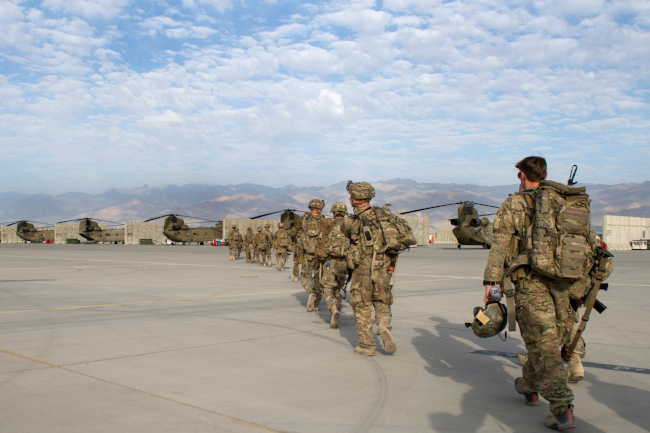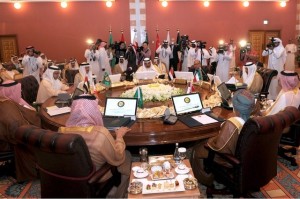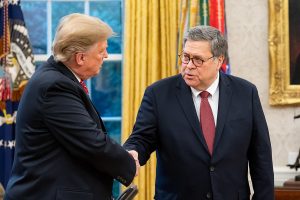by Robert E. Hunter
President Barack Obama took several months, and his direct personal engagement throughout that period, to decide that the United States should remain militarily engaged in Afghanistan. President Donald Trump took far less time, was far less engaged, left most of the thinking to his generals, and came to more or less the same conclusion.
That is the most important fact to emerge from President Trump’s August 21 announcement of the US strategy regarding Afghanistan.
The two presidents’ decisions do have important differences. Most important, Obama set a time limit of 18 months for his surge 0f 30,000 troops, at which point a reduction would begin. Trump, by contrast, said, “A core pillar of our new strategy is a shift from a time-based approach to one based on conditions.” In the use of military force to secure US interests, this is the only approach that makes sense. Time limits are for football and basketball, not for matters of war and peace. Without an objective and a means of determining whether it has been met, expending blood and treasure is not just unintelligent, it is also immoral, at least regarding the American service members who risk their lives and limbs in the effort.
This conclusion of course begs the question whether continued US military engagement in Afghanistan makes sense in terms of promoting US national security and that of regional and other countries that are important to us. That is far less clear. Indeed, in retrospect, it is not clear that there were compelling security and strategic reasons for the United States to invade Afghanistan in the wake of the September 11, 2011, terrorist attacks. It was called a “war of necessity,” but that was true only in the sense that an overwhelming majority of Americans – this author included – felt a need for vengeance in response to the assault on the nation by terrorists who operated primarily from Afghanistan. Limiting the capacity for Osama bin Laden and al-Qaeda to attack the United States again did not require invading Afghanistan, toppling its government, and eventually occupying the entire country. The invasion was essentially punitive. Ironically, the US never considered attacking Saudi Arabia, the homeland – and primary source of inspiration – for 15 of the 9/11 hijackers.
Reasons for the War
US post-Cold War military ventures in South Asia and the Middle East were engendered, in major part, by two factors.
The first is a consensus that the United States must keep terrorism from its shores to the extent possible. However, a simple but unpalatable truth is that stopping all terrorism is impossible, especially the “mom-and-pop” variety on display in the use of vehicles in several European cities to kill people. US leaders also need to try measuring the extent to which military involvement in the Middle East and South Asia, including widespread “collateral damage” to civilians, has become a recruiting tool for terrorism’s leaderships. Countering the Islamic State (ISIS or IS), with its capacities, location, organization, tenacity, and intentions, is essential. That conclusion is less obvious regarding other US military efforts, including in Afghanistan.
The second factor is that, following the collapse of the Soviet Union, the United States had the opportunity, in the judgment and aspirations of many American leaders and commentators, to reshape the structures of societies, politics, and economies in this part of the world. The aftermath of the misbegotten 2003 US invasion of Iraq has disabused all but the most diehard exponents that that invasion was among the worst follies of American history. Further, every effort at “nation building” in this part of the world has so far failed. To his credit, Trump argues for no longer “trying to rebuild countries in our own image, instead of pursuing our security interests above all other considerations.”
So why is the United States still involved in Afghanistan and is even increasing its military engagement, although by a modest amount of perhaps 4,000 or so troops? A case can be made, as President Trump and his two predecessors did, that the Kabul government’s collapse would open the way for the Taliban to regain dominance and that could lead to increased terrorism against the West, including the United States. Yet given the territories already open to al-Qaeda and its ilk, including IS, it is far from clear that adding Afghanistan to the list of possibilities would make matters worse.
Further, there is one ineluctable fact about Islamist terrorism that none of the last three administrations has been willing to face: the inspiration for most of the terrorism, along with much of the funding, comes from by far the world’s leading exporter of terrorism—Saudi Arabia and its fanatical religious creed, Wahhabism. US leaders have refused to confront Saudi involvement because of its oil but also because domestic American political constituencies have promulgated the idea that Iran is a deadly enemy of the United States, which justifies unquestioned support of Saudi Arabia and some other Sunni states, including Riyadh’s ruthless and unconscionable assault on Yemen. It will not be possible finally to defeat Islamist terrorism—not in Afghanistan, Pakistan, the Middle East, Africa, or Southeast Asia—without calling a halt to the export of Wahhabism and the support for terrorism by some of America’s nominal Sunni allies.
In addition, what the United States, along with some allied and partner nations, has already done in Afghanistan has made little decisive, positive difference despite nearly 16 years of effort. The Taliban controls more territory than it has for years. And there is no obvious basis for believing that further US military commitment—whether “training,” “advising,” “providing air support,” or “stiffening”—will succeed now when it has so far proved inadequate. For whatever reason, including the structure of the country’s political and economic power, the Afghan government and military forces have not been able to do the job. It’s wishful thinking to imagine that the United States—and perhaps NATO allies, as President Trump is asking—will succeed, against all odds, in the face of Afghan incapacity to respond sufficiently to the challenge. As President Trump put it succinctly: “Ultimately, it is up to the people of Afghanistan to take ownership of their future, to govern their society, and to achieve an everlasting peace.”
Trump’s Initiative
Like President Obama, President Trump argues that this time will be different. He proposes the “integration of all instruments of American power—diplomatic, economic, and military—toward a successful outcome.” In dealing with difficult security problems, this is wise counsel. But it now flies in the face of a proposed 27% cut in the State Department’s budget and the inability of the secretary of state, seven months into the new administration, to organize his department for action or put in place more than a handful of officials—an all-time record for delay.
Further, the president does hold out that “after an effective military effort, perhaps it will be possible to have a political settlement that includes elements of the Taliban in Afghanistan.” But he rightly confesses that “nobody knows if or when that will ever happen.” Meanwhile, the US will continue its open-ended commitment, with little realistic hope of a positive outcome.
Although President Trump got some things right in his August 21 announcement, he got at least two other things wrong. He argued, for instance, that “our nation must seek an honorable and enduring outcome worthy of the tremendous sacrifices that have been made, especially the sacrifices of lives.” That argument must never be used to justify continuing a war policy if it cannot achieve important goals for national security. Carl von Clausewitz, the father of modern strategy, warned against this trap two centuries ago—that, in effect, nations tend to escalate political goals to justify losses already sustained.
Clausewitz also argued, in his most famous proposition, that “war Is merely the continuation of policy by other means.” Frequently misinterpreted to mean that politics stops when war starts, he meant the exact opposite: that whatever is done in war must continually be measured against the securing of political/policy objectives. Given this truism, it is hard to see how the United States can justify continuing its seemingly endless military engagement in Afghanistan, when the objectives have lost most of their rationale and the chances of achieving even these are so poor.
So, why are we still in Afghanistan?
Here, President Trump gave the lead in the administration’s basic review of US Afghanistan strategy to Secretary of Defense James Mattis, a retired general. Perhaps the president was thus seeking political cover in case the outcome was a decision to end US engagement, given that “my original instinct was to pull out.” Bearing in mind Georges Clemenceau’ s maxim that “war is too important a matter to be left to the military,” however, leadership of the strategic review should have been given to the secretary of state or to a non-military national security official in the White House.
In the final analysis, it may be that Trump, treading in Obama’s footsteps, decided to persevere in Afghanistan for a special, political, but understandably human reason: the fear of being seen to lose a war. Regarding Vietnam, President Lyndon Johnson said it directly: “I’m not going down in history as the first American President who lost a war.” And yet he and the nation did, seven long years and tens of thousands of American dead later. Afghanistan is less costly to the United States in blood and treasure. But that is no argument for further sacrifice, however limited it could prove to be.
President Trump should go beyond the Afghanistan policy review to explore the potential ways and means of ending US engagement and to place that country in a broad and comprehensive geopolitical and geoeconomic context.
This should include a strategic analysis of factors across the entire region, the further development of means to cripple Islamist terrorism that do not depend on having US forces in Afghanistan, the enlistment of other countries in efforts to deal with that country and the broader region, and the application of all tools of American statecraft, including the promotion of a region-wide security structure that will be necessary to forestall the “vacuum” of which Trump has warned. In that way, the president can best ensure that, as Clausewitz would have counseled, “policy” will prevail over “war” and not the other way around.
Photo: U.S. soldiers leaving Bagram Airfield, Afghanistan, June 23, 2015. Courtesy U.S. Air Force and Tech. Sgt. Joseph Swafford.






President Obama, March 27, 2009
A new strategy for Afghanistan and Pakistan
REMARKS BY THE PRESIDENT
ON A NEW STRATEGY FOR AFGHANISTAN AND PAKISTAN
“I want the American people to understand that we have a clear and focused goal: to disrupt, dismantle and defeat al Qaeda in Pakistan and Afghanistan, and to prevent their return to either country in the future. . . .together with the United Nations, we will forge a new Contact Group for Afghanistan and Pakistan that brings together all who should have a stake in the security of the region — our NATO allies and other partners, but also the Central Asian states, the Gulf nations and Iran; Russia, India and China.”
But Obama did no such thing, instead he increased the US troop level by 70,000 (not 30,000) to over 100,000, with no positive results. Now Trump promises nothing: “Someday, after an effective military effort, perhaps it will be possible to have a political settlement that includes elements of the Taliban in Afghanistan, but nobody knows if or when that will ever happen.” .. .
Dream on about a successful military effort and a political settlement.
Mikhail Gorbachev knew when to cut his losses and withdraw from a war the\at USSR could not win and which the Soviet Empire no longer could afford to fight. American warhawks ignore that our supply lines to fight in Afghanistan run through quasi-enemy Pakistan, and the former alternative lines ran through Russia and Tajikistan — routes that seem no longer available. Some columnist recently compared our “longest war” to a 400-year Byzantine war in modern Turkey; but a war fought with swords and on horseback 500 years ago doesn’t compare with a 21st century war fought with missiles and aircraft that consume imported fuel, and paid for with borrowed money.
Afghanistan for the US is really about Washington’s New Silk Road policy, a longstanding urge to extend US power up into Central Asia. The US “New Silk Road concept has a history that predates Obama and Clinton, going back at least to the “Silk Road Strategy Act of 1999.” This idea was probably one of the prime strategic motivators for the US involvement in Afghanistan, which is the keystone to Central Asia from the south. There has been a significant infusion of soft power by the US in Central Asia, particularly involving Kazakhstan, including USAID and US chambers of commerce, but geographical access is a problem. The only US access to Afghanistan and Central Asia is via Iran (not) or Pakistan — now a US enemy.
In 2011 General Dave Petraeus and his tiger team at the U.S. Central Command (CENTCOM) were front and center, creating an inclusive New Silk Road strategy with plans for infrastructure that would go through Afghanistan and turn enemies into friends and aid into trade. And all of this would promote shared prosperity and collective security. But behind the scenes policy was starting to change. General Petraeus left CENTCOM and became the commander of the International Security Assistance Force (ISAF) in July 2010. General James Mattis (now SecDef) replaced Petraeus and was the CENTCOM Commander from August 2010 until March of 2013. General Mattis felt the U.S. State Department should run the New Silk Road. So by 2013 Mattis had zeroed out the funding for the New Silk Road tiger team at CENTCOM. China turned the tables on America by filling this gap with its own version of the New Silk Road which it called “One Belt, One Road.”. . .US stupid, China smart.
Its very clear that no policy in Afghanistan, and basically the whole region makes sense without an established ‘partner’ in Iran. In fact, Iran can stabilize Afghanistan (for the U.S. and the west) and even strategic linkages within the region are best fulfilled ‘though’ Iran. Iran is the key. Even the Taliban (Sunni, former Iran foes) could be ‘controlled’ by Iranian forces – if needed. The fundamental flaw in US-Afghan policy is the absence of a real Iran policy. That is the basic problem. BUT, the US has played its card in Iran, and with Iranians very poorly, and has very limited room to maneuver. More importantly, its ‘closeness’ with the Saudi’s, while sanctioning Iran is a major strategic mistake — which will further isolate Iran, and delay any rapprochement with Iran… and therefore in turn help improve regional stability. Iran has been pushed into the hands of the Soviets and Chinese! Another big mistake. There was a time when the U.S. partnered with BOTH the Saudi’s and Iran!! (Pre-Jimmy Carter). There was a time, when the U.S. had bases in Iran, and Iran in turn policed the region … everywhere from insurgents in Oman, to Afghanistan. There was a time, when there was a regional alliance in CENTO – and the region had more stability. The U.S. has undermined its own policies in the region with one mistake after another. Focusing on Afghanistan without full consideration of the region as a whole is a mistake! If, in fact, the U.S. can not establish a partnership with Iran, and develop a regional policy – it has NO business in Afghanistan, and should just walk out. There will be NO success in Afghanistan, without a holistic regional approach. (And to be clear, I am not saying the Mullahs are the best partners U.S. can find in Iran … something has to change INSIDE Iran… for there to be a new partnership. And by the way, Saudi backed opposition groups like MEK/MKO/NCRI etc. won’t cut it as partners in Iran either. There has to be a big POSITIVEV shift!)
One note- call those we are fighting in Afghanistan all the names you want but remember they are the ones who built the houses and businesses and have raised families there for a thousand years. Why stay there destroying their family life?